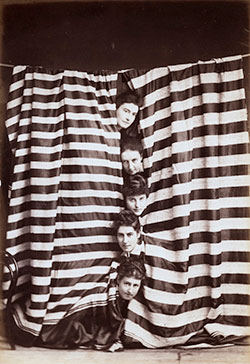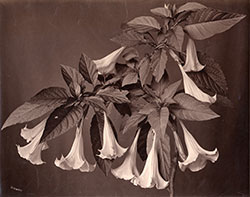About collecting
 There are many possible approaches to starting a collection of photographs. Today, few individuals have the resources to gather a high quality collection encompassing the entire history of photography from 1839 to the present. Instead, collectors might decide to base their collection around a particular period in history, a specific format or photographic process, a geographical location, a favourite photographer or a preferred subject matter or aesthetic style. A sensible approach is to look at as many types of imagery as possible from dealers, museums and auctions before taking the plunge.
There are many possible approaches to starting a collection of photographs. Today, few individuals have the resources to gather a high quality collection encompassing the entire history of photography from 1839 to the present. Instead, collectors might decide to base their collection around a particular period in history, a specific format or photographic process, a geographical location, a favourite photographer or a preferred subject matter or aesthetic style. A sensible approach is to look at as many types of imagery as possible from dealers, museums and auctions before taking the plunge.
Even so, do not expect always to be happy with your earliest purchasing decisions in the months and years ahead. 'Bad choices', i.e., photographs we no longer care for, should not be cause for disappointment. The great fun of collecting is how our discernment alters as we hone our 'eye' and increase our knowledge. It would be boring if our aesthetic leanings were fully developed on day one. So do not regret, after firmly deciding to collect 1930s American portrait photographs related to the Farm Security Administration, if you are later drawn to 1860s architectural photographs of India or 1950s French snapshots. Indeed, one of the great joys of collecting is in discovering exciting pictures that we would not have initially purchased because we did not even know this imagery existed.
The encouraging news is that despite prices that have escalated out of all proportion from nearly 40 years ago when we started in the field, there is still much to discover in collecting photographs, even at reasonable prices. Unlike some other art forms, photography has a very rich variety and images of quality are not restricted quite so severely by the existence of a limited number of schools and studios from which the majority of the best work has emerged.
Today, it is still possible to discover great photographers whose names have been forgotten or who remain anonymous. The collector with discrimination may also uncover new areas of collecting which have been previously overlooked. Hand-coloured photographs, cartes de visite, photographic artist's studies, the so-called 'vernacular', press prints and early views of neglected corners of the world, are still areas which are relatively underrated. The rulebook as to which photography is worth collecting is still being written. Collectors with ambition, diligence and a keen eye may wish to add to that unfinished tome. Do not make the mistake of thinking that everything of interest is already in the history books and the museums. It is not.
A commonly seen aesthetic approach in photograph collecting closely mimics the normative judgments applied to the collecting of more traditional works like painting despite the intrinsic nature of photography and its history being significantly different from that of earlier art forms. Indeed, this is a point frequently made by historians and curators, yet these same individuals sometimes struggle with photographic themes that do not also resonate within the history of art. Thus, photographs acquired by art museums often have familiar echoes in the general history of art, eg., studies of ancient ruins or views of the Forest of Fontainebleau. Since great painters themselves have long copied such themes if not the actual works of their earlier colleagues, such referential photographic imagery can be not only very beautiful but also certainly of significant interest. Collecting them exclusively, however, to the detriment of images that perhaps derive their character more specifically from the photographic process, such as instantaneous snapshots or primitive tintype portraits, is a disservice to what one might perceive as the essential nature of photographic art. This possible blind spot in mainstream collecting, nevertheless, provides opportunities for the discerning collector or museum.
K&J Jacobson are personally biased towards the exotic, unconventional and eclectic - photographs which were not always intended to be works of art. We find the most powerful emotional impact comes from images of a more documentary nature. This is no doubt related to the photograph's essential function as a recorder of reality. These pictures often have no equivalent in the painting world and not only frequently represent remarkable value for the collector, but we believe them to be at the heart of what is most exciting in 19th century photography.
 The monumental feat of sifting the wheat from the chaff - the gems from the mountain of mundane pictures - might once have been a pleasant weekend preoccupation of patient collectors who loved visiting antique fairs, flea markets, auctions and antiquarian book shops. As these venues are becoming scarcer and the discovery of photographs in them has become increasingly uncommon, museums and collectors might have to depend more than ever on dealers for the enormous job of making 'preliminary selections' for the aspiring collector.
The monumental feat of sifting the wheat from the chaff - the gems from the mountain of mundane pictures - might once have been a pleasant weekend preoccupation of patient collectors who loved visiting antique fairs, flea markets, auctions and antiquarian book shops. As these venues are becoming scarcer and the discovery of photographs in them has become increasingly uncommon, museums and collectors might have to depend more than ever on dealers for the enormous job of making 'preliminary selections' for the aspiring collector.
Individuals can be diffident about buying a photograph because of worries about the rarity or lack thereof of photographs. They wonder how many prints were made from a single negative and whether they are scarce? Until well into the 20th century, photographers rarely numbered their photographs, so one usually has no idea how many prints were made from a single negative. This uncertainty can have an unsettling effect on collectors. Some would be satisfied to know with absolute certainty that an artist's lithograph printed in 1860 was made in an edition of 200. When they discover that a photographic print from the same year had an unknown number printed, even though we know of perhaps a mere five prints that still survive, they become unsettled. How do we know that another 1000 prints will not be discovered tomorrow, they ask? We usually explain that we can't have absolute certainty, but that such an event is highly unlikely if only five prints have emerged after 160 years.
The main reason for the relatively low numbers of photographic prints on the market from a specific negative is that, throughout history, there has rarely been a point in photographers slaving away (darkroom and earlier printing-out techniques could be quite laborious) to make more prints than they were able to sell. Also, until relatively recently, photographic prints were not considered art investments. If one considers the vast majority of prints that were thrown away, the significant likelihood of deterioration in those that survive and the many uninteresting tourist views produced that now hold little interest for the modern collector, these ravages of history have deemed that the survival of almost any fine condition silver print of an outstanding image is now a scarce if not a rare item. The images presented on this web site have been selected out of many thousands of mediocre and faded prints from the marketplace.
Another question revolves around whether to collect 'vintage' photographs, that is, photographs produced roughly during the same period as the negative. The term 'vintage', itself, is often difficult to define with any accuracy. There are sometimes reasons for buying prints made later. In most cases, however, we much prefer photographs made roughly at the time of the negative, rather than printed at a later date when the photographer, estate or agent is producing the prints essentially to capitalize on the fame of the artist. Of course, if one is interested in contemporary digital images, made on the computer rather than by the camera, the issues discussed above can become even more complicated.
Although we believe that collectors should learn as much as possible about early photography, ultimately they must begin to cultivate and trust their own taste. By buying what their friends tell them is fashionable or good, they will miss much of the enjoyment, discovery and passion that makes this field so exciting. We would not advocate buying photography for investment purposes alone. It might be noteworthy, however, to observe the gestation of many art collections, including photographic ones, which have ultimately become very valuable. These compilations were often gathered together by an individual who became besotted with their subject while their contemporaries thought them to be quite mad.
Although there is certainly much to chose from in contemporary and 20th century photography, our own experience and predilections lead us to point to the remarkable value still available in 19th century photography. Though the long term reputation of most 21st century photographers is still uncertain, quality images by many 19th century photographers are often firmly established by curators and historians; furthermore, a fine example of work over 130 years old may still be purchased for a reasonable price. We are always happy to speak with new collectors and help with any questions about collecting.
